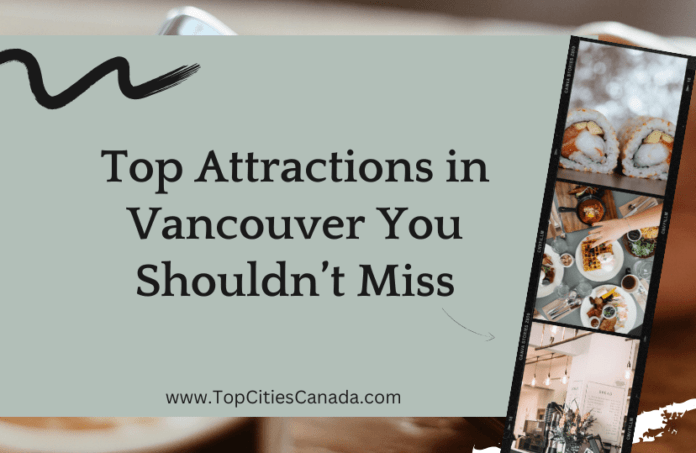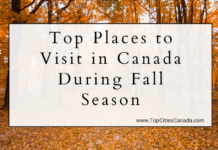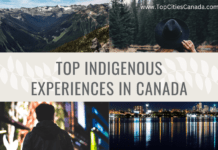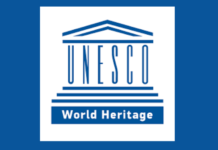Vancouver, a vibrant coastal city in British Columbia, Canada, is renowned for its stunning natural landscapes and diverse cultural attractions.
Here are some of the top attractions in Vancouver that visitors should not miss:
Stanley Park: A Detailed Overview
Stanley Park, located in Vancouver, British Columbia, is a stunning 405-hectare (1,001-acre) public park that serves as a green oasis amidst the urban landscape. It is bordered by the waters of Burrard Inlet and English Bay, making it one of North America’s largest urban parks.
The park’s rich history, diverse ecosystems, and numerous attractions make it a must-visit destination for both locals and tourists.
Stanley Park has a deep historical significance. Originally inhabited by Indigenous peoples for thousands of years, the area became a focal point during the 1858 Fraser Canyon Gold Rush when British colonization began.
The land was initially set aside for military fortifications but was transformed into Vancouver’s first park when the city was incorporated in 1886. Named after Lord Stanley, the 16th Earl of Derby and Governor General of Canada at the time, the park officially opened in September 1888.
Unlike many urban parks designed by landscape architects, Stanley Park evolved organically over time, blending natural forest with urban development.
Natural Features
The park is characterized by its lush West Coast rainforest, featuring approximately half a million trees, some reaching heights of up to 76 meters (249 feet) and hundreds of years old.
Despite facing challenges from windstorms that have caused significant tree loss, efforts have been made to preserve and restore its natural beauty. The park’s diverse ecosystems include dense forests, beaches, lakes, and wildlife habitats.
Key Attractions
- Seawall: The park is famous for its 9-kilometer (5.6-mile) seawall that encircles its perimeter. This scenic pathway is popular for walking, jogging, and cycling, offering breathtaking views of the ocean and mountains on one side and lush forest on the other. The seawall is an ideal route to access various attractions within the park.
- Totem Poles: Located at Brockton Point, these totem poles are among the most visited attractions in British Columbia. They represent the rich cultural heritage of Indigenous peoples and provide insight into their art and history.
- Vancouver Aquarium: Situated within Stanley Park, this world-class aquarium is home to thousands of marine animals and focuses on conservation efforts. It offers educational programs and interactive exhibits that highlight marine life.
- Beaches: Stanley Park features several beaches, including Second Beach and Third Beach. Second Beach has family-friendly amenities like a swimming pool and playgrounds, while Third Beach offers a more tranquil setting for relaxation and sunset viewing.
- Wildlife: The park is a haven for wildlife enthusiasts. Visitors can spot various species such as blue herons near Lost Lagoon or encounter squirrels and other small animals along the trails.
- Trails: With over 27 kilometers (16 miles) of trails winding through the park, there are plenty of options for hikers and nature lovers. Popular trails include Beaver Lake Trail and Rawlings Trail, each offering unique experiences in the natural surroundings.
Visitor Information
Stanley Park is open year-round and free to enter. It offers various amenities such as washrooms and picnic areas. Visitors can reach the park easily via public transportation or by bike. During peak summer months, it’s advisable to arrive early to avoid crowds, especially at popular attractions like the aquarium.
Stanley Park stands as a testament to Vancouver’s commitment to preserving natural spaces within an urban environment. Its combination of scenic beauty, cultural significance, and recreational opportunities makes it an essential destination for anyone visiting Vancouver.
Whether you’re exploring its trails, enjoying a meal with ocean views, or learning about Indigenous culture through guided tours, Stanley Park promises an unforgettable experience in nature’s embrace.
Granville Island: A Comprehensive Overview
Granville Island is a vibrant and culturally rich peninsula located in the Fairview neighborhood of Vancouver, British Columbia. Situated across False Creek from downtown Vancouver, this unique destination has transformed from an industrial area into a bustling hub of arts, culture, and culinary delights.Historical Background
Originally inhabited by the Musqueam and Squamish peoples, Granville Island was used as a fishing area long before European settlement. The area was named after Granville Leveson-Gower, the 2nd Earl Granville, and became part of Vancouver’s landscape in the late 19th century.
In 1915, the Vancouver Harbour Commission initiated a reclamation project to create an industrial area, which eventually became known as Granville Island. The island was built using fill dredged from False Creek and was initially home to various factories and warehouses that supported the city’s booming logging and fishing industries.
By the 1970s, Granville Island underwent significant redevelopment. The old industrial buildings were repurposed to accommodate artists, artisans, and food vendors, leading to its current status
There are many more places to travel and enjoy in Canada.










